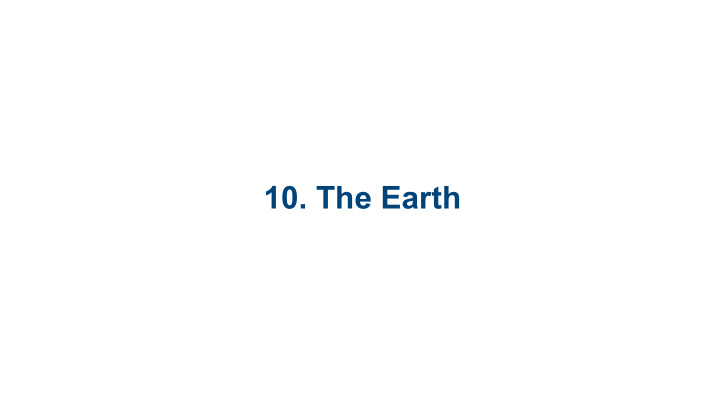



10. The Earth
10.1 Earth’s Atmosphere 10.2 Earth’s Layers
10.1 Earth’s Atmosphere
What is the atmosphere? The earth is surrounded by several layers of gases, which are essential to supporting life by absorbing energy and heat from the sun, trapping water near the surface, and moderating weather. These layers extend 350 miles into space.
The atmosphere of earth is made up of mostly nitrogen and oxygen. Other Nitrogen Oxygen 1% 21% 78%
The atmosphere is divided into five different layers, or strata , that differ from each other in temperature, density, and chemical composition. They are separated from each other by four transition zones.
The troposphere is closest to earth’s surface, extending 9 miles from the surface. It has the greatest density, and contains 99% of the water vapor in the atmosphere. Most weather is caused by the interactions of gases in the troposphere. It is separated from the stratosphere by the tropopause.
The stratosphere extends 9 miles from the tropopause. The protective ozone (O 3 ) layer that absorbs UV radiation is here It is separated from the mesosphere by the stratopause.
The mesosphere is 30-50 miles above earth’s surface, with temperature decreasing outwards to as low as -110 degrees C. It has a very low density of gases, with almost no ozone or water. It is separated from the thermosphere by the mesopause.
The thermosphere is 50-300 miles above earth’s surface, with low gas density. The temperature in the thermosphere can rise as high as 1980 degrees C with the absorption of solar radiation by O 2 . It is separated from the exosphere by the thermopause.
The exosphere extends from the thermopause by about 620 miles. Due to its extremely low density of mostly hydrogen and helium particles and low gravitational forces, it is difficult to define.
10.2 Earth’s Layers
The earth itself is also divided up into layers, either chemically (crust, mantle, and core) or functionally (lithosphere and asthenosphere) The crust is the entire outer surface of the earth, and is rich in oxygen, silicon, and aluminum.
The mantle is the middle layer of earth and accounts for 82% of the earths volume. It is thought to be rich in iron, magnesium, silicon, and oxygen. The mantle is aplastic – it has the properties of a solid but flows like a liquid under high pressure.
The core is the center layer of earth and is composed of mostly molten iron and nickel . The core itself has two zones – a liquid outer core and a solid iron inner core.
The layers of earth can also be classified as the lithosphere and the asthenosphere. The lithosphere ( lithos - stone) is composed of the crust and the rigid mantle layer. The asthenosphere ( asthenos – no force) is composed of the molten plastic outer mantle of rock beneath the lithosphere.
Recommend
More recommend